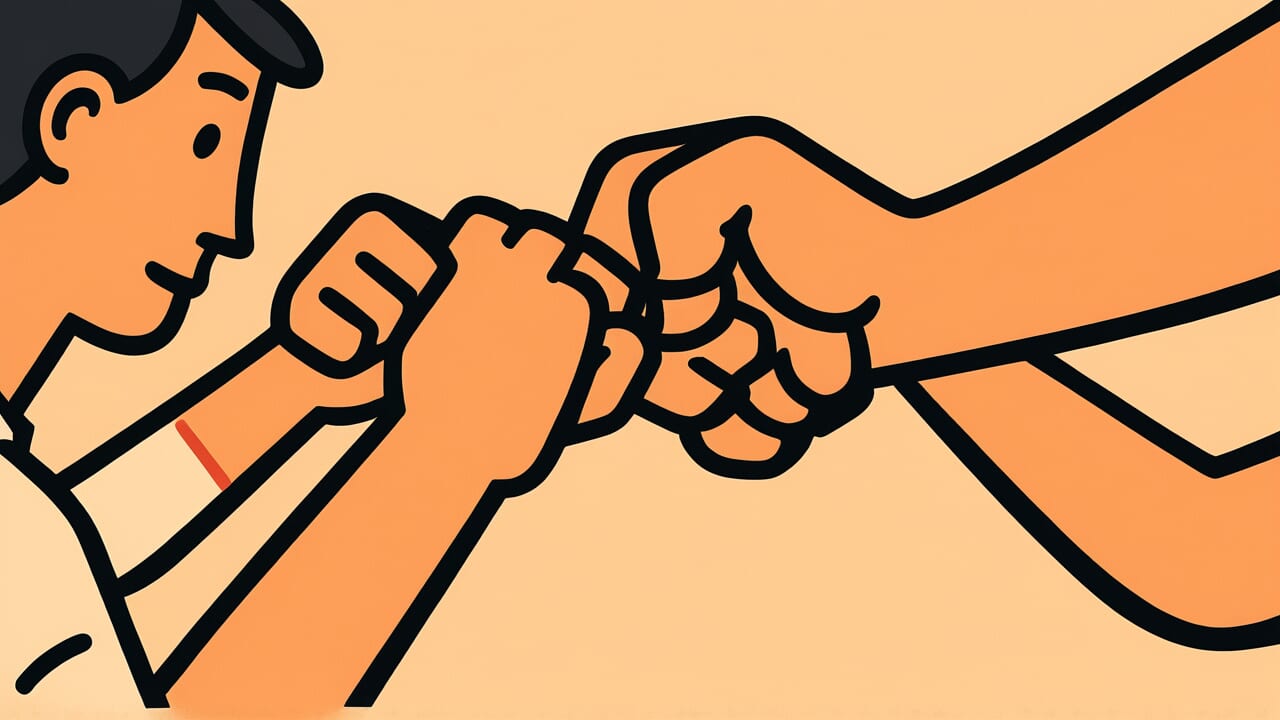How to Read “Arm wrestling with a pillar”
Daikokubashira to udaoshi
Meaning of “Arm wrestling with a pillar”
“Arm wrestling with a pillar” describes a situation where no amount of effort can make a difference. Imagine trying to push a massive pillar that supports an entire house using just your arm strength. No matter how hard you push, the pillar won’t budge. This overwhelming difference in power is the heart of this proverb.
This proverb is used when the gap in ability between you and your opponent is so huge that effort seems pointless. It applies to sports matches against much stronger opponents, amateurs challenging experienced experts, or individuals standing up to massive organizations or authorities.
It doesn’t just mean “you can’t win.” It expresses a difference so overwhelming that even trying feels meaningless.
Origin and Etymology
No clear historical records explain the origin of this proverb. However, we can learn a lot by looking at the words themselves.
The “daikokubashira” is the thickest and most important pillar in a house. In traditional Japanese wooden architecture, this central pillar supports the entire building’s weight. It’s impossible to move or shake.
The name “daikoku” likely comes from Daikokuten, one of the Seven Lucky Gods who protects household prosperity.
“Udaoshi” means pushing with your arm. Human arm strength is limited. Even the strongest person cannot move a pillar that supports an entire building.
This proverb probably came from construction sites or daily life. People actually tried to move these pillars and failed. The image of pushing with all your might against something that won’t budge at all left a strong impression.
It became a saying that everyone could understand. Our ancestors used a simple building metaphor to express an obvious power difference.
Interesting Facts
In traditional Japanese wooden buildings, a daikokubashira typically measures 30 to 50 centimeters in diameter. Large ones can exceed one meter. They weigh hundreds of kilograms to several tons.
These pillars support the entire building’s load. They literally cannot be moved by human strength alone.
Interestingly, because the daikokubashira stands at the center of the home, it also became a metaphor for the central person in a family. “The daikokubashira of the household” still means the main breadwinner today, separate from this proverb’s meaning.
Usage Examples
- As a new employee, challenging the industry’s top company is like arm wrestling with a pillar
- His skills are overwhelming. If I challenge him, it’ll just be arm wrestling with a pillar
Universal Wisdom
“Arm wrestling with a pillar” contains a truth humans have understood for ages. Some walls cannot be overcome through effort alone. This is a harsh but realistic recognition.
We want to believe that “you can achieve anything if you try hard enough.” But our ancestors knew that idealism alone won’t get you through life. When facing an overwhelming power difference, continuing a reckless challenge can sometimes become foolishness.
This proverb teaches us the wisdom to assess such situations calmly.
However, this saying doesn’t recommend giving up. Rather, it teaches the importance of choosing the right opponent and the right method. Pushing a pillar with your arm is useless, but with the right tools or a different approach, a path might open.
Fighting head-on with brute force isn’t the only way to battle.
This proverb has been passed down because humans have always faced their limitations while continuing to search for ways to live. Recognizing a power difference isn’t defeat. It’s the first step toward developing a smarter strategy.
When AI Hears This
A daikokubashira is structurally optimized for “top-to-bottom” force. The larger the pillar’s cross-section, the stronger it becomes against vertical compression. Meanwhile, when a human pushes with their arm, that’s “sideways force.” This direction wasn’t part of the pillar’s design.
What’s fascinating is the “second moment of area,” a value that represents the pillar’s strength. A pillar with a 30-centimeter diameter has an enormous value of about 400,000 cubic centimeters.
In contrast, the bending moment a human arm can generate is only about 500 Newtons times the arm’s length, even when a 60-kilogram person pushes with full force.
To tilt the pillar, you’d need thousands of times more force at its base. Humans can’t produce even one-hundredth of that.
Even more interesting is “force transmission efficiency.” When you push with your arm, the force spreads from the pillar’s surface inward. Wood fibers running lengthwise (vertically) are hard, while the cross-grain direction is relatively soft.
This means sideways force gets absorbed at the pillar’s surface and barely affects the overall structure. Your arm gets tired, but the pillar doesn’t move at all.
This proverb brilliantly expresses two physical mismatches: force direction and material properties.
Lessons for Today
This proverb teaches modern people the importance of strategic thinking. In the age of social media, anyone can raise their voice. But at the same time, we increasingly feel powerless when facing overwhelming power differences.
What matters is understanding that recognizing a power gap is different from giving up. Pushing a pillar with your arm is useless, but you might move it with a lever.
Instead of a frontal assault, there might be another angle, another method, or another timing for your challenge.
In modern society, individual power may be small, but people with shared goals can create great strength together. Digital technology also gives us ways to tackle problems that were once impossible.
This proverb warns against reckless challenges while teaching the value of living wisely. Understand your own strength correctly. Analyze situations calmly. Choose the most effective method.
This kind of wisdom becomes the power to survive in the modern world.



Comments